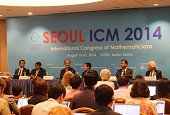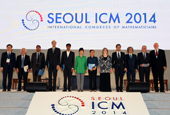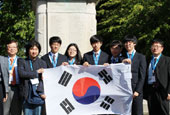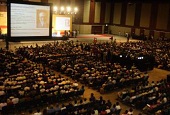The International Congress of Mathematicians (ICM) opened in Seoul on August 13 with a ceremony for the Fields Medal, known as the "Nobel Prize of mathematics." Honors went to: Artur Avila, a 35-year-old mathematician and a senior researcher at the National Center for Scientific Research (CNRS); Manjul Bhargava, a 40-year-old chair professor at Princeton University in the U.S.; Martin Hairer, a 38-year-old professor at the University of Warwick in Britain; and, Maryam Mirzakhani, a 37-year-old professor at Stanford University in the U.S. Mirzakhani has now become the first ever female winner of the award in the ICM's 117-year history. The recipients of other awards, including the Nevanlinna Prize, the Carl Friedrich Gauss Prize, and the Chern Medal, were also announced.
The Nevanlinna Prize is given to a mathematician who contributes to mathematical information sciences. The prize was named in honor of Finnish mathematician Rolf Nevanlinna (1895-1980), who was the honorary chairman of the 18th ICM held in Helsinki, Finland, in 1978. The Carl Friedrich Gauss Prize for Applications of Mathematics received its name from the German mathematician Carl Friedrich Gauss (1777-1855), who is known for his accomplishments in geometry and algebra. Premiering in 2006, it is awarded every four years during the opening ceremony of the ICM, which is only held once every four years. The Chern Medal is named in honor of the late Chinese-American mathematician Shiing-Shen Chern (1911-2004). It was first granted at the 26th ICM in Hyderabad, India, in 2010. Prize money for the award is USD 500,000, the highest among all the awards given at the ICM.
The Nevanlinna Prize went to Subhash Khot, an Indian-American mathematician, while the Carl Friedrich Gauss Prize was given to Stanley Osher, an American. Phillip Griffiths, another American, won the Chern Medal.
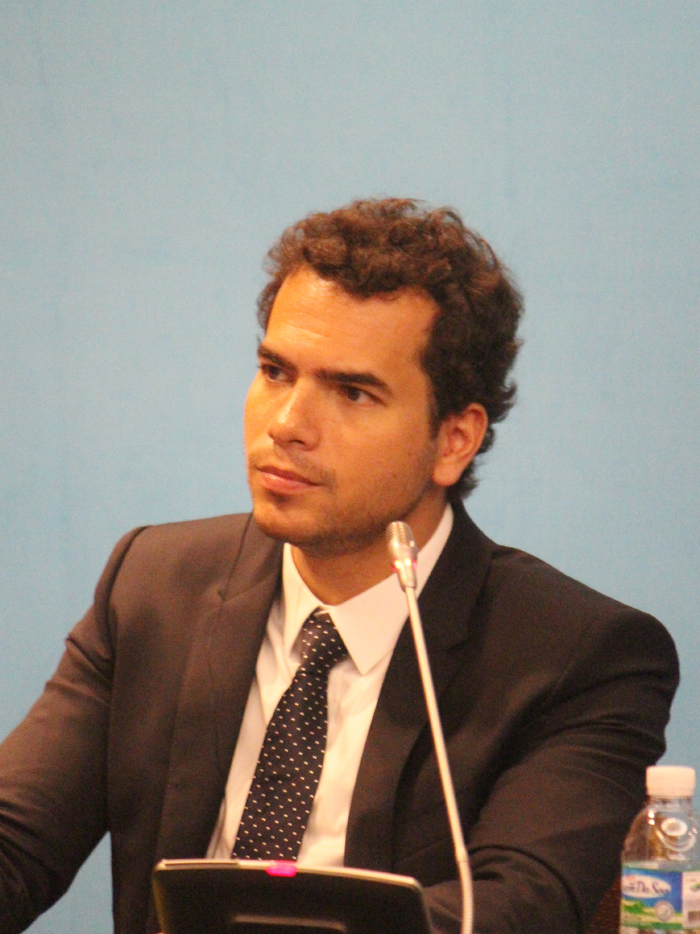
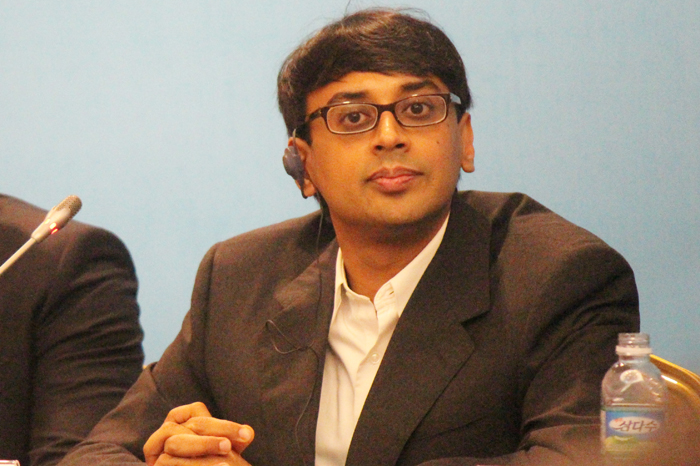
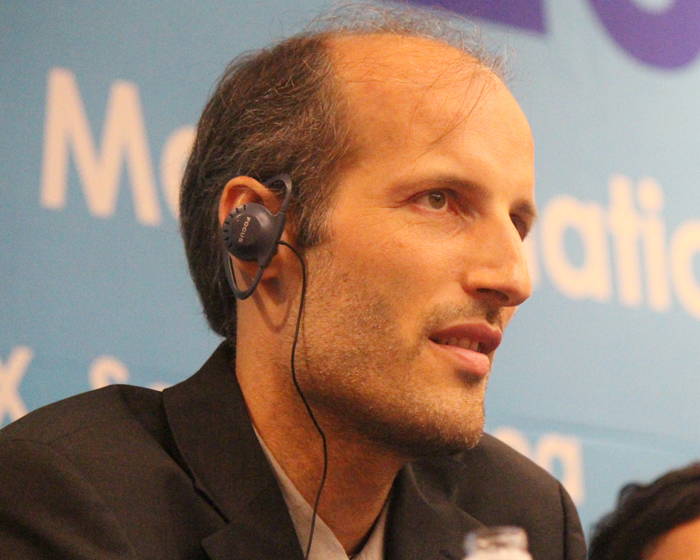
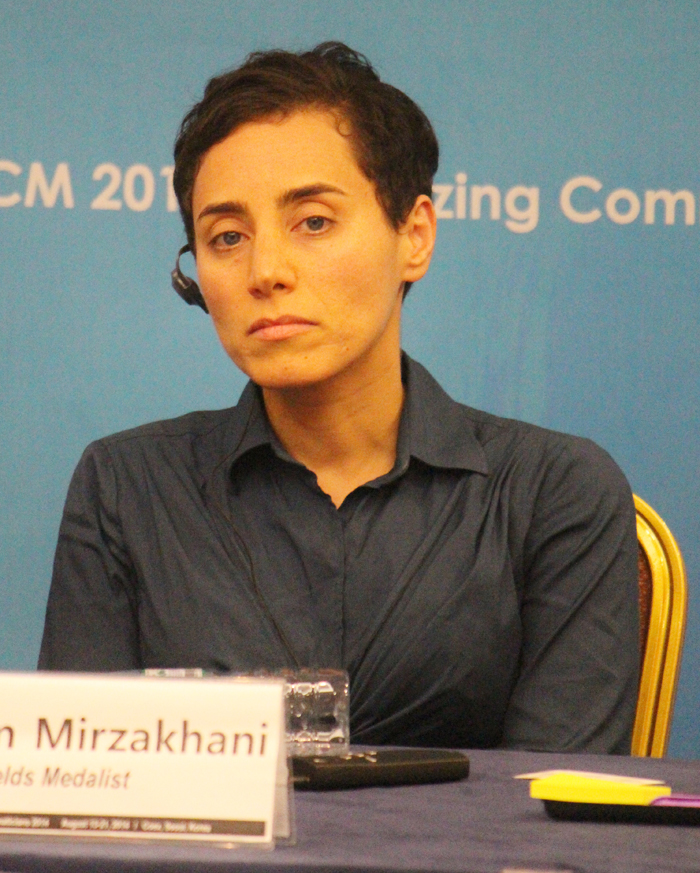
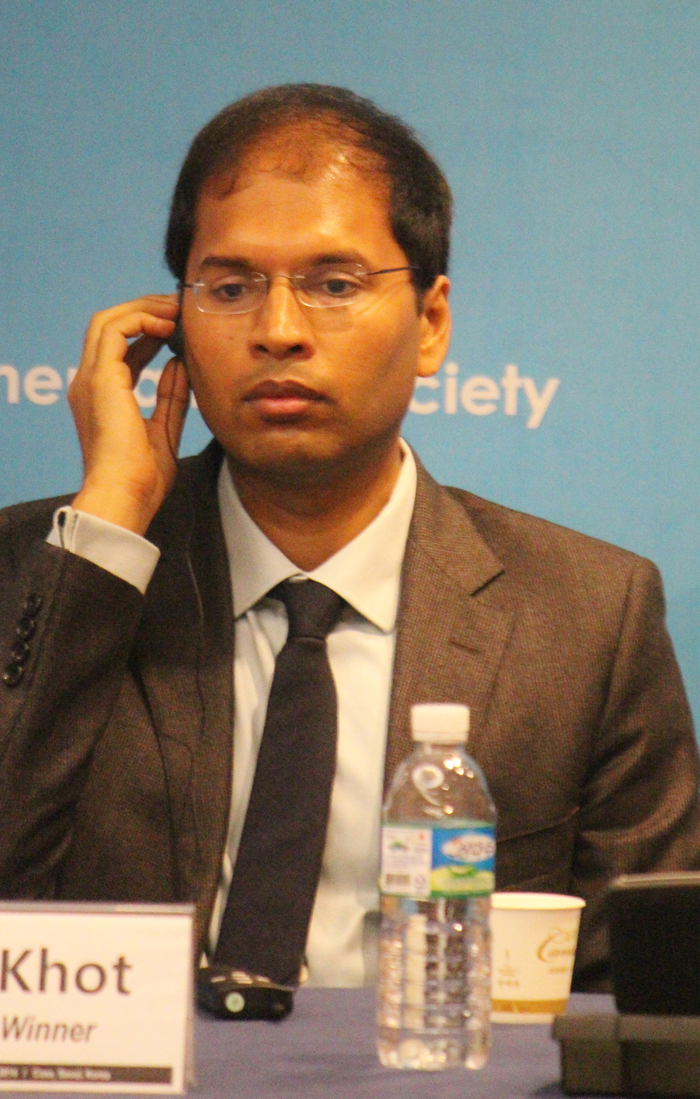
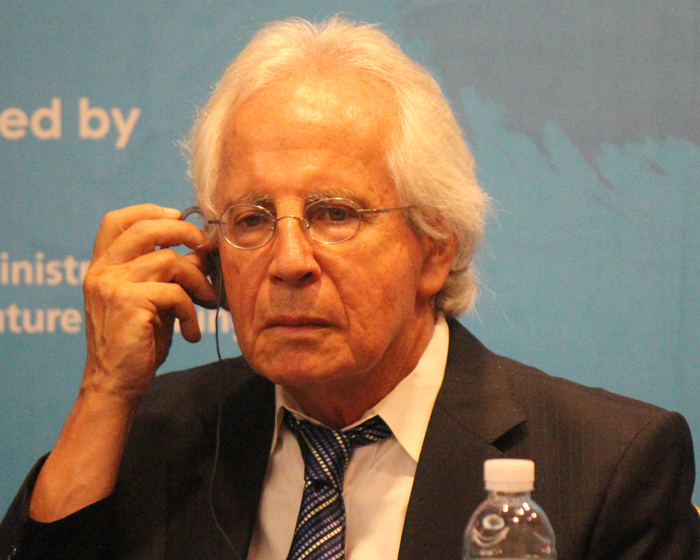
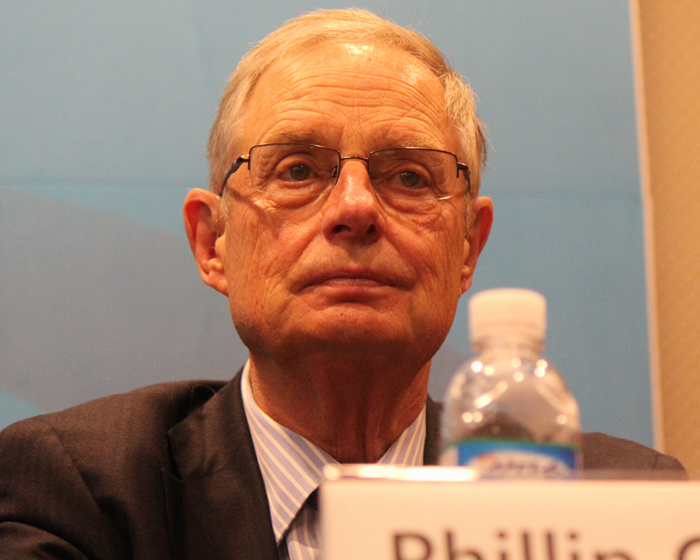
o Fields Medal winner Artur Avila
Artur Avila was born in Brazil in 1979 and received his Ph.D. at the National Institute for Pure and Applied Mathematics (IMPA) in Rio de Janeiro. Avila became the first recipient of the award who obtained his Ph.D. in a region or country other than Europe or the U.S. He is now a CNRS senior researcher at the Institut de Mathématiques de Jussieu-Paris Rive Gauch. He is being recognized for his outstanding work in his specialty field, primarily concerning dynamical systems and analysis. He proved that in various classes of dynamical systems, a randomly chosen object moves regularly or arbitrarily.
o Fields Medal winner Manjul Bhargava
Manjul Bhargava, born in Canada in 1974, graduated from Harvard University and received his Ph.D. at Princeton University. Bhargava’s thesis at Princeton provided a reformulation of Gauss’ law, or an arithmetic formula, for the composition of two binary quadratic forms with the use of Rubik's cube. He then developed the law further and expanded it into a more complicated polynomial expression, discovering 13 arithmetic formulas.
o Fields Medal winner Martin Hairer
Martin Hairer, born in Austria in 1975, received his Ph.D. in physics at the University of Geneva in Switzerland. Now, he teaches at the University of Warwick in Britain. He made contributions to the theory of stochastic partial differential equations, and in particular created a theory of regularity structures for such equations, making a breakthrough in challenging formerly unsolved problems. Hairer is also a computer programmer and a piece of audio editing software he created while a student has since been commercialized.
o Fields Medal winner Maryam Mirzakhani
Maryam Mirzakhani, born in Tehran, Iran, in 1977, received her Ph.D. at Harvard University in 2004. Now she teaches at Stanford University. Mirzakhani has made stunning advances in the theory of Riemann surfaces and their moduli spaces, and leads the way to new frontiers in this area. Her insights have integrated methods from diverse fields, such as algebraic geometry, topology and probability theory.
o Nevanlinna Prize winner Subhash Khot
Born in India, Subhash Khot graduated from the Indian Institute of Technology in 1999 and received his Ph.D. at Princeton University in 2003. He is an associate professor at the Courant Institute of Mathematical Sciences at New York University. He is known for his prescient definition of the “unique games” problem, and his leadership in the effort to understand its complexity and its pivotal role in the study of efficient approximation of optimization problems. He has produced breakthroughs in algorithmic design and approximation hardness, and has worked on new and exciting interactions between computational complexity, analysis and geometry.
o Carl Friedrich Gauss Prize winner Stanley Osher
Stanley Osher, an American, received his Ph.D. at New York University. He now teaches at UCLA. He made contributions to several fields in applied mathematics, and his far-ranging inventions have changed our conception of physical, perceptual and mathematical concepts, giving us new tools to comprehend the world. His contributions in a variety of fields in applied mathematics include high resolution shock-capturing methods for hyperbolic equations, level set methods, PDE-based methods in computer vision and image processing, and optimization.
o Chern Medal Award winner Phillip Griffiths
Phillip Griffiths got his bachelor's degree at Princeton University in 1962 and has taught as a professor at the University of California, Berkeley, Princeton and Harvard. He is now an honorary professor at the Institute for Advanced Study at Princeton. He is known for his groundbreaking and transformative development of transcendental methods in complex geometry, particularly his seminal work in Hodge theory and periods of algebraic varieties. He has written many classic expository papers and books, such as, “Principles of Algebraic Geometry,” with Joseph Harris, that have inspired students of the subject since the 1960s.
By Wi Tack-whan, Limb Jae-un
Korea.net Staff Writer
whan23@korea.kr
The Nevanlinna Prize is given to a mathematician who contributes to mathematical information sciences. The prize was named in honor of Finnish mathematician Rolf Nevanlinna (1895-1980), who was the honorary chairman of the 18th ICM held in Helsinki, Finland, in 1978. The Carl Friedrich Gauss Prize for Applications of Mathematics received its name from the German mathematician Carl Friedrich Gauss (1777-1855), who is known for his accomplishments in geometry and algebra. Premiering in 2006, it is awarded every four years during the opening ceremony of the ICM, which is only held once every four years. The Chern Medal is named in honor of the late Chinese-American mathematician Shiing-Shen Chern (1911-2004). It was first granted at the 26th ICM in Hyderabad, India, in 2010. Prize money for the award is USD 500,000, the highest among all the awards given at the ICM.
The Nevanlinna Prize went to Subhash Khot, an Indian-American mathematician, while the Carl Friedrich Gauss Prize was given to Stanley Osher, an American. Phillip Griffiths, another American, won the Chern Medal.




Fields Medal winners at the ICM in Seoul: (from top) Artur Avila, a CNRS senior researcher in France; Manjul Bhargava, a chair professor at Princeton University; Martin Hairer, a professor at the University of Warwick; and, Maryam Mirzakhani, an American professor at Stanford University. (photos: Wi Tack-whan)



(From top) Nevanlinna Prize winner Subhash Khot, a professor at New York University; Carl Friedrich Gauss Prize winner Stanley Osher, a professor at the University of California, Los Angeles; Chern Medal winner Phillip Griffiths, an honorary professor at the Institute for Advanced Study.
o Fields Medal winner Artur Avila
Artur Avila was born in Brazil in 1979 and received his Ph.D. at the National Institute for Pure and Applied Mathematics (IMPA) in Rio de Janeiro. Avila became the first recipient of the award who obtained his Ph.D. in a region or country other than Europe or the U.S. He is now a CNRS senior researcher at the Institut de Mathématiques de Jussieu-Paris Rive Gauch. He is being recognized for his outstanding work in his specialty field, primarily concerning dynamical systems and analysis. He proved that in various classes of dynamical systems, a randomly chosen object moves regularly or arbitrarily.
o Fields Medal winner Manjul Bhargava
Manjul Bhargava, born in Canada in 1974, graduated from Harvard University and received his Ph.D. at Princeton University. Bhargava’s thesis at Princeton provided a reformulation of Gauss’ law, or an arithmetic formula, for the composition of two binary quadratic forms with the use of Rubik's cube. He then developed the law further and expanded it into a more complicated polynomial expression, discovering 13 arithmetic formulas.
o Fields Medal winner Martin Hairer
Martin Hairer, born in Austria in 1975, received his Ph.D. in physics at the University of Geneva in Switzerland. Now, he teaches at the University of Warwick in Britain. He made contributions to the theory of stochastic partial differential equations, and in particular created a theory of regularity structures for such equations, making a breakthrough in challenging formerly unsolved problems. Hairer is also a computer programmer and a piece of audio editing software he created while a student has since been commercialized.
o Fields Medal winner Maryam Mirzakhani
Maryam Mirzakhani, born in Tehran, Iran, in 1977, received her Ph.D. at Harvard University in 2004. Now she teaches at Stanford University. Mirzakhani has made stunning advances in the theory of Riemann surfaces and their moduli spaces, and leads the way to new frontiers in this area. Her insights have integrated methods from diverse fields, such as algebraic geometry, topology and probability theory.
o Nevanlinna Prize winner Subhash Khot
Born in India, Subhash Khot graduated from the Indian Institute of Technology in 1999 and received his Ph.D. at Princeton University in 2003. He is an associate professor at the Courant Institute of Mathematical Sciences at New York University. He is known for his prescient definition of the “unique games” problem, and his leadership in the effort to understand its complexity and its pivotal role in the study of efficient approximation of optimization problems. He has produced breakthroughs in algorithmic design and approximation hardness, and has worked on new and exciting interactions between computational complexity, analysis and geometry.
o Carl Friedrich Gauss Prize winner Stanley Osher
Stanley Osher, an American, received his Ph.D. at New York University. He now teaches at UCLA. He made contributions to several fields in applied mathematics, and his far-ranging inventions have changed our conception of physical, perceptual and mathematical concepts, giving us new tools to comprehend the world. His contributions in a variety of fields in applied mathematics include high resolution shock-capturing methods for hyperbolic equations, level set methods, PDE-based methods in computer vision and image processing, and optimization.
o Chern Medal Award winner Phillip Griffiths
Phillip Griffiths got his bachelor's degree at Princeton University in 1962 and has taught as a professor at the University of California, Berkeley, Princeton and Harvard. He is now an honorary professor at the Institute for Advanced Study at Princeton. He is known for his groundbreaking and transformative development of transcendental methods in complex geometry, particularly his seminal work in Hodge theory and periods of algebraic varieties. He has written many classic expository papers and books, such as, “Principles of Algebraic Geometry,” with Joseph Harris, that have inspired students of the subject since the 1960s.
By Wi Tack-whan, Limb Jae-un
Korea.net Staff Writer
whan23@korea.kr
